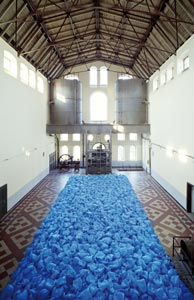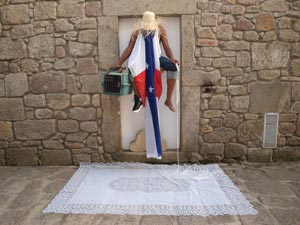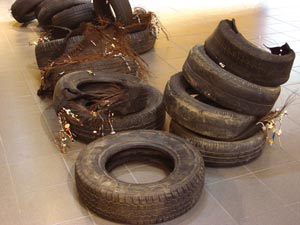Conversation about the Caribbean and Central America with José Manuel Noceda
José Manuel Noceda, researcher, critic and curator at the Wifredo Lam Contemporary Art Center in Havana, for several years he has been serving as curator of exhibitions and events in Central America and the Caribbean, geographical areas to which he has devoted numerous essays in journals, books and catalogs.
 Noceda, today in some sectors of the critics and curation they repeatedly speak of the importance of the Caribbean and Central America as emerging areas with a high level of artistic practices, especially if you look at the number of international exhibitions involving artists of these regions, as well as events devoted exclusively to them. What is truth in all this? Is it an “in” phenomenon or of true recognition?
Noceda, today in some sectors of the critics and curation they repeatedly speak of the importance of the Caribbean and Central America as emerging areas with a high level of artistic practices, especially if you look at the number of international exhibitions involving artists of these regions, as well as events devoted exclusively to them. What is truth in all this? Is it an “in” phenomenon or of true recognition?
There is some truth in what you mention. These geocultural areas are going through a good phase in the production and circulation of visual arts, well deserved in fact. These areas have been invisible for many years, being seen as extremely peripheral contexts in the Western Hemisphere, in the shadow countries with much more tradition such as Argentina, Brazil, Colombia or Mexico. Really, only Cuba stood out in a special manner and to a lesser extent the Dominican Republic, Puerto Rico and Haiti, beginning with the popular school of painting promoted at the Port au Prince Centre d’Art founded by Dewitt Peters in the early forties of the last century. You could also say that Jamaica, Trinidad and Tobago... While Central America was historically completely ignored: Belgica Rodriguez said that, this region was always over flown, always to “jumping” from Mexico to Colombia without passing through it. Now the circumstances have changed. Today, Central America and the Caribbean are emerging contexts of great strength.
Has this happened in the last fifteen or twenty years or are these recent circumstances?
The Caribbean made headway; since the late eighties what I call a “new vanguard” began to flourish in the region, with a group of young artists that joined up with other more experienced ones. That’s why I prefer to speak of a new avante-garde sensitivity, rather than a generational movement. Remember that by then you could find some well established artists in the Caribbean, such as: David Boxer (Jamaica), Antonio Martorell (Puerto Rico), Peter Minshall (Trinidad and Tobago), Ernest Breleur (Martinique)... and this other group of young creators joined them. In other words, something happens that had never happened before, because this update happens even on the smaller islands.
Are you talking about Capellan, Marcos Lora, Raul Recio (Dominican Republic), Francisco Cabral (Trinidad & Tobago)....?
Yes, and about Chris Cozier (Trinidad & Tobago), Annalee Davis (Barbados), Elvis Lopez (Aruba), Victor Vazquez and Pepón Osorio in Puerto Rico, Yubi Kirindongo in Curacao, just to mention some names, which start to become recognized names in the nineties by coining a new image of the Caribbean in the field of visual arts.
Usually, about this region frequently mentioned are its great writers: Naipaul, Derek Walcott, Carpentier, Aime Cesaire, Edouard Glissant, Nicolás Guillén. More than any other, that was, and still is, a well-known literary Caribbean. Just as in Central America they spoke of Miguel Angel Asturias, Augusto Monterroso, and afterwards of Roque Dalton. These artists, and for example Edna Manley, Stanley Greaves, Fwomajé Group, did not stand out internationally as the younger ones do now?
I don’t think so. But you’re talking about mid-twentieth century ‘til the eighties, and I am focusing on the contemporary, on what’s happening now. Remember that at the moment that you’re speaking of modernism was already taking place in Cuba and certain movements in the Dominican Republic, Jamaica, among other exceptions that never much exceeded the regional environment. There were personalities, movements, which sometimes did not reach beyond their borders. There wasn’t any historian or curator, who thought much about them, other than in very specific cases such as Wifredo Lam in Cuba, and some specific areas of the Cuban vanguard....
 What interested New York’s MoMA at the time, when Alfred Barr was director, who was in Cuba in the early forties...?
What interested New York’s MoMA at the time, when Alfred Barr was director, who was in Cuba in the early forties...?
Exactly. The same happened with the Haitian Painting School that was of interest in the US. The points of attention were very specific and limited, to which later were added the likes of Herve Telemaque, Haitian painter that developed his work in Paris as part of the French pop. Now a very interesting phenomenon is happening that reverses this constant, clearly as a result of the postmodern “inclusivism”, from the global logic of the contemporary world. But returning to your original question, the Caribbean emerges strongly in the late eighties, early nineties, and Central America had to wait a little longer. That is, to allow time for the internal wars and conflicts that plagued the region and that affected the whole isthmus to finish, so that a new art dynamics could emerge, a group of young artists that changed the situation. Both contexts, remember, were eminently pictorial, those of a painting quite detached from reality, and in that sense...
...nourished by the European the avant-garde?
No. In this sense, the school of painting of the Caribbean and Central America were trapped in a dead end until well into the eighties, heavily influenced by modernism of the twentieth century. It was a late modernistic trend.
Nothing to do then with the art movements of the sixties and seventies: pop, op art, conceptualism, nor with Brazilian concretism, Venezuelan kinetic art...
Not at all. Influenced, like I said, by the early avant-garde, and within them let’s say, by some movements and trends more than others. For example, surrealism left and almost indelible mark on the painting and sculpture of the first half of the twentieth century in the Caribbean. In Central America oneirism as well as garciamarquianic magic realism theories were the ones, which in my opinion, ruled much of the representation. Those orientations prevailed in an exhibition like Magic and Realism. Central American Contemporary Art, 1992 and Belgica Rodriguez’ book: Central American Art, an approach, published in 1994.
Then there’s a shift towards the object, towards installations: a turn almost vertiginous. I think that in Central America and the Caribbean, beyond fashion and trends, a visuality of great strength and impact is being built, subject to context constraints, to life circumstances that mark the creation. Historical alibis and memories on one hand; and on the other: existence, the present, new stages of life, along with the entrance into consumer society.
Might we then not speak of practices that come from the art history, forms, certain aesthetic experiences?
There are, of course, turns of phrase that this new production legitimizes, there is new media. To give you an example in Central America now, video is very important, even video games. I think of Jorge Alban, the Costa Rican photographer, who has explored how the technological platform of the video game is used in art. I think it’s also important to mention the performances of Priscilla Monge (Costa Rica), Regina Jose Galindo (Guatemala), the actions of Humberto Vélez (Panama). There is a strong interest in discussing about urban life and in developing actions and projects in the public arena. Anyways, some are still interested in art history in the processes of creation and language, amongst them Federico Herrero (Costa Rica), who reformulates the principles of painting while in parallel doing installation work or urban interventions, although as I said, the predominant group leans more towards looking into the contextual particularities.
And there is, Nelson, a very important element worth noting: the number of women artists working in the areas that concern us: Annalee Davis, Sheena Rose and Joscelyn Gardner (Barbados), Irene Shaw (Trinidad and Tobago), Belkis Ramirez, Raquel Paiewonsky, Quisqueya Henríquez and Monica Ferreras (Dominican Republic), Carolina Caycedo, Nayda Collazo and Dhara Rivera (Puerto Rico), Alida Martinez, Osaira Muyale and Glenda Heyleger (Aruba), as well as other younger ones. In Central America Monge and Galindo, and Sila Chanto, Lucia Madriz, Karla Solano and Cynthia Soto (Costa Rica), Regina Aguilar and Xenia Mejía (Honduras), Donna Conlon from Panama, Patricia Belli and Patricia Villalobos (Nicaragua), as well as Alexia Miranda and Dalia Chevez in El Salvador.
 Well now, could it be said that the institutions, both educational as well as museums and galleries have had some influence in this, as it happened in Cuba?
Well now, could it be said that the institutions, both educational as well as museums and galleries have had some influence in this, as it happened in Cuba?
At the beginning there were spontaneous, natural movements. Afterwards they received a support of institutions, indeed, by means of events and exhibitions, such as national biennials emerged in each Central American country, including Paiz in Guatemala, which is the oldest of them all. It is significant how these biennials articulate a network of local events that conclude at the Isthmus as a grand finale. Later on, with an international projection, the Havana Biennial; Santo Domingo’s Central American and Caribbean painting Biennial (which considers the Caribbean as one common basin, and thus the West Indies together with the continental countries bordering the Caribbean Sea take part in it).
In some of the islands we can speak of the role played by other institutions such as the Caribbean Contemporary Art in Trinidad and Tobago in the nineties. In terms of education we cannot ignore the role played by the Higher Institute of Arts (ISA), in Cuba, the Altos de Chavon School in the Dominican Republic, the National Arts School in Puerto Rico, the Jamaica School of Arts converted into the Edna Manley School of Visual and Performing Arts in Jamaica, the Ecole Régional d’Art Plastiques Martinique, today Institut Régional d’Arts Visuels ... See how some educational institutions are changing their profiles, opening spaces for new disciplines. Well now, I must say that some artists fill a certain educational gap becoming facilitators of new spaces for training and exhibition, generating workshops, etc. Differences apart, these are experiences similar to what happened with the DUPP gallery and the Conduct workshop, both at the ISA, Havana. I can tell you about the cases of Elvis Lopez and his Atelier 89 in Aruba; Tirzo Martha and David Baden with the Buena Bista Institute in Curacao, the foundation in Suriname run by Marcel Pinas, Alice Yard space in Trinidad and Tobago, and Beta-Local in Puerto Rico, among others. In Nicaragua Patricia Belli is developing a project similar to EspIRA, “La ESPORA”.
Something curious is that Martinique and Barbados are becoming 2 important poles in the Caribbean. They organize symposiums and events systematically: in Martinique noteworthy exhibitions; Entre-vues, exhibition of contemporary Caribbean photography (2008), and Atlantide Caraïbe (2009), Vous etes ici (2010), and recently, Caraïbe en expansion. Barbados, meanwhile, has convened several conferences, including the symposium-exhibition Black Diaspora Visual Arts, 2009, and The Black Jacobins, in March 2011. They jointly develop the AICA Caraïbe Sud website with abundant information about events, artists, institutions and art critic of (and about) the region.
Regarding expositions, within the last twenty years quite a few joint projects of considerable dimension have been dedicated to the Caribbean. Beginning this stage several events take place: Caribbean Visions in the United States, 1995, and Insular Caribbean in Badajoz and Madrid, Spain, 1998; and later on Infinite Islands, at the Brooklyn Museum in New York, 2007, Global Caribbean for the fair Art Basel Miami Beach, 2009, Restling with the images for the Museum of the Americas, Washington DC, 2010. On the other hand, the Dominican Republic’s Museum of Modern Art reopens the space that the Biennial of Central America and the Caribbean had occupied, converted now into the CaribbeanInternational Triennial (the “Greater Caribbean”, including southern United States), whose first edition was held in September last year.
In another vein, some personalities played a decisive role in Central America: Virginia Pérez-Ratton, first as founding director of the Museum of Contemporary Art and Design, and then from TEOR/Etica in Costa Rica, was the tutelary figure that brought together critics and curators; Rosina Cazali in Guatemala; Monica Kupfer, Carmen Aleman and Adrienne Samos in Panama; Bayardo Blandino in Honduras,; Ileana Alvarado and Tamara Diaz in San Jose, Costa Rica, Juanita Bermúdez in Nicaragua.
Between 2000 and 2005 two major exhibitions took place that projected Central America beyond its borders: Oscillations and artifacts, curated by Vivian Loría for the Atlantic Centre of Modern Art of Las Palmas de Gran Canaria, with a Mesoamerican approach that incorporates Mexico, and All-inclusive: Central American urban images, curated by Santiago Olmo and Virginia Pérez-Ratton. The latter also organized Doubtful Strait, 2006, an event which put Central America into dialogue with other parts of the world. We also have the traveling project Landings from 2003 to 2009, organized by Joan Duran, Belize, that made it all the way to Asia, and just recently Santiago Olmo dedicated the entire XXXI Biennial of Pontevedra in Spain, to the Caribbean and Central America.
Has this phenomenon touched the rest of the Americas?
Generally speaking South American countries have remained somewhat on the border of the visual environment of these regions. In recent editions of the Biennials of Sao Pablo, Mercosur, Cuenca, there has been certain closeness, but except for isolated cases like these, you may notice some departure from the rest of Latin America. When you study the lists of guests in the catalogs of macro-expositions you realize how very few names of Central American or Caribbean origin are taken into account. There is more interest in the United States, all the shows that I mentioned, in Europe (specifically in Spain, France, former colonial powers): let’s remember the case of Regine Cuzin, who organized several editions of the Latitudes project, dedicating two of them to the Caribbean. I find what happens in Spain particularly interesting and appealing, as the curators are more familiar with contemporary art from those areas of the world. I mean Antonio Zaya and Maria Lluisa Borras, who frequently visited the Caribbean, attended the Biennials of Havana and Santo Domingo, and organized Cuba XX Century: modernness and syncretism, and then later conceived Insular Caribbean.
What about the market?
I don’t believe that you can talk about a market for the Caribbean and Central America. If you analyze fairs and auction catalogs, artists from these regions are counted, really very few. There are some procedures that open doors today, there is a limited local market, unsystematic, spontaneous; some fairs in Santo Domingo come up, Circa in Puerto Rico. Social classes with more resources buy the works of national artists, without a lot of criteria. The taste of collectors works. There is a market area that takes into account some aspects of contemporary art, but in most cases classic stereotypes prevail.
There is the Cuban case, which has opened its own path. Following is the Dominican Republic with a substantial network of galleries, and Puerto Rico which is renowned for its exhibition spaces and its connection to the United States. Some artists are able to insert their works in the Daros Latinamerica Collection, others in spaces like the IVAM in Spain, but they are few, isolated cases. I do not think emerging artists in the region enjoy a stable internal market. They work with typologies that do not interest the private market, and they are not acquired by the large institutions within and outside the region. They enjoy certain level of legitimacy, access to exhibition spaces, scholarships, residences, and their work circulates internationally, but they still do not have a well defined market.
 In Central America we have the case of the Ortiz-Gurdian Foundation...
In Central America we have the case of the Ortiz-Gurdian Foundation...
Ramiro Ortiz is perhaps one of the atypical cases in the region. It has been “opened” beyond the great collection which it treasures, linked to the tradition of which we spoke a moment ago (including works of European painters from the eighteenth and nineteenth centuries, as well as pieces of the Central American of painting and drawing), and now we can find segments devoted to young artists, as a result of the awards of the national biennials that he sponsors.
I view the market issue with suspicion, since in the United States they’re trying to capitalize on what is happening with Caribbean art, above all in Miami, which I believe aspires to become a cardinal center for contemporary art of the region.
Going back to issues noted when we began this dialogue, what in your opinion are the fundamental differences between the emerging generations and those that prevailed in earlier times?
There is a group of youngsters working inside and outside the region (the diaspora) that are like the successors of the promotions released in the nineties. They intensively take on video, performance, and photography. In the Caribbean, something unique happens; many artists come from the world of design. In Central America there is a post minimalistic will with objects and installations of medium and small format, which takes advantage of the symbolism of the materials. They also work with mixed media. In those nineties installations prevailed, together with spatial displays. I think the issues and problems of that time still remain valid, although the way to address and represent them is changing, and many other issues with political and social reflexivity perspectives, which is really significant.
In Central America, I can point out some prominent names such as: Angel and Fernando Poyon brothers and the La Torana group in Guatemala; Dalia Chevez and Mauricio Esquivel in El Salvador, Mauricio Miranda, Esteban Piedra and Lucía Madriz (Costa Rica); Ernesto Salmeron and Marcos Agudelo in Nicaragua; Adam Vallecillo and the Lamanchadetomate group (Honduras); while in the Caribbean we can name: Ebony Patterson and Nicole Awai, Jamaica; Marlon Griffith, Trinidad and Tobago; Blue Curry (Bahamas); Hew Locke (Guyana); Jean-François Bocle and Shirley Rufin in Martinique; Joëlle Ferly (Guadeloupe); Ryan Oduber and Ken Wolf in Aruba, Tirzo Martha in Curacao, the Dominicans Raul Morilla, Natalia Ortega and David Pérez, Karmadavis; Marxz Rosado and Carlos Ruiz Valarino in Puerto Rico; Sheena Rose in Barbados, among others...
The exchange with Noceda ended in this manner. Next time, we hope to encourage him to publish many other stories about both regions. Clearly, we must stay alert in regards to everything that happens in these geographical areas that today are strongly emerging in the visual arts global panorama. I think that fortunately, we are leaving behind the days when the image of the Caribbean was just beautiful beaches, coconuts, glasses of rum, mulattos and mulattas, calypso, reggae, soukha, merengues, and sones. And as we all know, as far as Central America goes, scarcely a reference to the sad historical status of "banana" republics.
Related Publications

How Harumi Yamaguchi invented the modern woman in Japan
March 16, 2022












